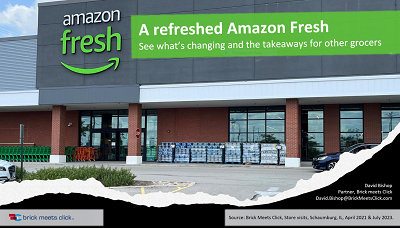February 2024 U.S. eGrocery Sales Total $7.9 Billion, Down 10% versus Year Ago
Complete the form below to instantly download this month's dashboard.
The U.S. online grocery market finished February with total monthly sales of $7.9 billion, down 10.5% compared to 2023, according to the most recent Brick Meets Click/Mercatus Grocery Shopper Survey fielded February 28-29, 2024. Delivery sales defies the overall downward trend while the gap between Mass and Grocery repeat intent rates reaches a record high.
Topline
“Convenience remains one of the primary motivations for shopping online for groceries, however, for some customers, cost considerations are now weighing more heavily on their decision on how to shop,” said David Bishop, partner at Brick Meets Click. “This means that the explicit costs associated with eGrocery services are more likely to impact how these customers grocery shop, whether that’s returning to in-store or shifting where they shop online.”

Key Findings for Feb 2024
Lower average order values (AOV) were the central catalyst driving the downward YOY sales trends.
- Ship-to-Home dropped 15.4% and Pickup fell 12.8%.
- Delivery, the only method to expand sales, was up 4.7%, aided by a strong rebound in monthly active users (MAUs) versus last year.
No method was spared from the AOV downturn.
- Ship-to-Home and Pickup both fell 13% and Delivery contracted by 7% versus last year.
Most retailers and formats also experienced lower AOVs versus last year to varying degrees.
- Walmart had a relatively small 2% drop in AOV for Pickup and Delivery orders versus last year while the Supermarket format reported a 15% drop AOV for Pickup and Delivery compared to February 2023.
All three receiving methods expanded their respective MAU bases.
- These across-the-board gains were driven by an increase in the share of MAUs who received orders via multiple methods during the month as the overall user base slipped slightly, down 30 basis points (bps) compared to the prior year.
- Delivery, however, posted a significantly stronger expansion than either Pickup or Ship-to-Home due to easier comparisons versus last year.
Total order volume was flat YOY.
- While the total volume of eGrocery orders was essentially flat on a YOY basis, Delivery’s strong performance offset the order volume declines experienced by the other two methods. The number of orders fell 7% for Pickup and 3% for Ship-to-Home versus last year.
- In contrast, the 13% jump in Delivery order volume during February was predominantly driven by the expansion of its MAU base compared to the prior year, rather than a jump in order frequency.
Cross-shopping between Grocery and Mass grows YOY.
- The continued pressure on consumers’ purchasing power likely prompted the 170-bps increase in cross-shopping between Grocery (which includes Supermarket and Hard Discount) and Mass.
- More than 30% of households that bought groceries online from a Grocery service also did so from a Mass retailer’s service.
Repeat intent rates dropped to one of the lowest levels reported since 2021.
- This decline in composite repeat intent rate was driven by second- and third-time customers who were significantly less likely to use the same service again within the next 30 days compared to last year’s rates.
- Mass continues to outperform Grocery as the gap between their respective repeat intent rates reached a record high of more than 20 percentage points, driven by a dramatic slide in Grocery’s repeat intent rates compared to February 2023.
Message from our Sponsor
"Although regional grocers may not always be able to match the low prices offered by Mass merchants like Walmart, they can capitalize on customer insights to refine their service offerings" said Mark Fairhurst, Global Chief Growth Officer at Mercatus. "By using data to understand customer behavior, regional grocers can personalize shopping experiences, offer targeted savings, and ultimately, provide value that goes beyond pricing. This strategic use of customer data is essential for regional grocers to differentiate their services and maintain customer loyalty in a highly competitive market,” he added.
About this consumer research
The Brick Meets Click/Mercatus Grocery Shopping Survey is an ongoing independent research initiative created and conducted by the team at Brick Meets Click and sponsored by Mercatus.
Brick Meets Click conducted the most recent survey on February 28-29, 2024, with 1,755 adults, 18 years and older, who participated in the household’s grocery shopping, and a similar survey in February 2023, with a sample of 1,745.
Results are adjusted based on internet usage among U.S. adults to account for the non-response bias associated with online surveys. Responses are geographically representative of the U.S. and weighted by age to reflect the national population of adults, 18 years and older, according to the U.S. Census Bureau.
The three receiving methods for online grocery orders are defined as follows:
- Delivery includes orders received from a first- or third-party provider like Instacart, Shipt or the retailer's own employees.
- Pickup includes orders that are received by customers either inside or outside a store or at a designated location/locker.
- Ship-to-Home includes orders that are received via common or contract carriers like FedEx, UPS, USPS, etc.












